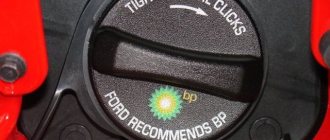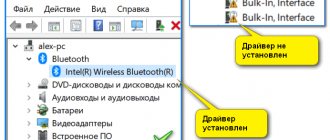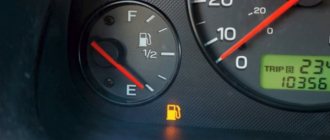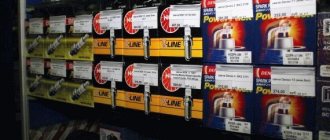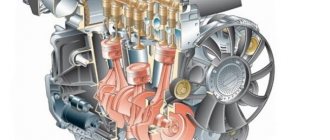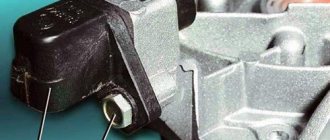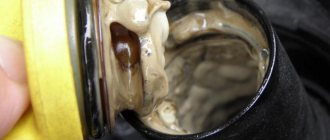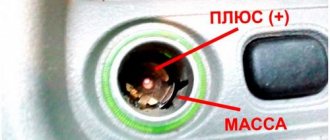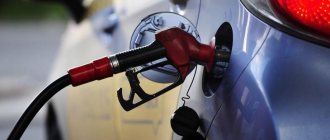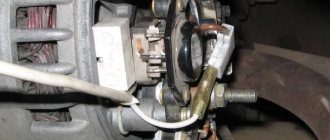The “Check Engine” icon may also turn on if the fuel pump and its filter are faulty. To check the functionality of the pump, you need to stop the car and listen to the sounds of the engine running.
To notify the driver of a car engine malfunction, in addition to standard indicators, there are also a number of additional ones. So, on the dashboard you can see the Check Engine indicator. What the check icon looks like in a car and what error codes there are are described below in the article.
What does it look like
An illuminated check engine light on a vehicle looks like a yellow or red “video camera” without an exclamation point, with the words Check Engine displayed inside or next to it. The indicator lights up on the car's dashboard (on the display behind the steering wheel). A photo of a picture with a receipt icon in a car is presented below.
Check badge in the car
The yellow “Check Engine” icon means that the car owner needs to independently change something in the car control system or take the car to a service station.
If the engine light is on in the car, then there are definitely the following faults:
- low-quality gasoline or other fuel is poured into the tank;
- spark plugs have failed;
- the integrity of the ignition system coil winding is damaged;
- there is a short circuit in the engine;
- The residual oxygen sensor (lambda probe) stopped working;
- the injectors are clogged;
- the catalyst does not work.
The Check Engine icon only blinks intermittently in the following situations:
- When the engine triples (not all the fuel burns). The check sign in the car lights up when a spark is missed. Unburnt fuel is discharged through the exhaust manifold.
- In case of critical wear of the catalytic converter. As a result, the car cannot be used.
- If the engine ECU fails.
The exact cause of a car breakdown can only be found out by diagnosing the ECU with an OBD 2 scanner or at a service station.
Replacing the oxygen sensor
The appearance of the “check car” message can be caused by damage or improper operation of the oxygen sensor (lambda probe). This element is an important part of the exhaust gas treatment system, which monitors the volume of remaining oxygen after combustion of the fuel-air mixture. the lambda probe fails,
- Sudden increase in fuel consumption.
- Reduced power of the power plant.
Modern cars are equipped with two or four oxygen sensors, so you will have to use an error scanner to determine the damaged part. If you have such a device in your garage, then checking the engine will be simple.
There are many reasons that cause damage or malfunction of this sensor. One of the most common is coating the part with oil soot, which prevents normal readings. As a result, fuel consumption begins to increase, and the exhaust system emits large amounts of harmful CO2.
When faced with such problems, you need to immediately change the oxygen sensor, otherwise another component, the catalyst, may fail. Repair of the latter is more expensive, which is due to the presence of precious alloys in its composition. And if several catalysts are installed in the car at once, then the total cost of repairs can reach 90,000 rubles. Such significant costs can be avoided if the sensor is replaced in a timely manner.
A new element is also not cheap, but its purchase will cost hundreds of times less than repairing the entire exhaust gas converter system. It is not difficult to replace an element with your own hands. To do this, it is enough to determine where the lambda probe is located and remove it to install a new one.
It may also be interesting: Polishing headlights is necessary when the headlights are cloudy
What does it mean
Check Engine is translated from English as “check the motor (engine).” The error code is indicated as follows: P0102… P0616.
The first letter of the error code identifies one of the car systems in which the breakdown occurred. There can be 4 codes in total:
- P - gearbox and/or engine;
- U - CAN bus;
- C - chassis;
- B - airbags, electric windows, central locking.
The second character after the letter indicates the type of error. The breakdown can be general (the same for all OBD II engines) or specific (for a specific car).
When the check icon appears
The second character of the error code is indicated by the following numbers:
- 0 - OBD 2 code;
- 1, 2 — manufacturer code;
- 3 - Reserved SAE (reserve).
The third character of the error code is the car subsystem where the failure occurred. The following numbers may appear on the receipt icon in your car:
- 1, 2 - injector circuit, fuel pump, fuel tank or air supply system;
- 3 - ignition system;
- 4 — auxiliary system (control);
- 5 — car speed, idle;
- 6 - ECU and its external circuits;
- 7, 8 — gearbox;
- 9, 10 - reserve.
The fourth and fifth characters of the error code indicate its serial number.
How to redeem a badge
The Check Engine icon remains on the vehicle's dashboard as long as there are still error codes in the OBD system's memory. After the fault is repaired, the codes are erased using a diagnostic tool. You can also extinguish the check icon in the car by disconnecting the terminals from the battery (for 3-5 minutes).
The easiest way in this case is to use a personal scanner. There are quite a lot of similar devices on the market, and an inexpensive car scanner will cost less than one visit to a service station. For example, we can recommend the multi-brand diagnostic scanner Rokodil ScanX.
The advantage of this model is that it is compatible with most cars produced in 1993 with an ODB2 connector. The scanner connects to any iOS, Android or Windows device via Bluetooth. In addition to resetting errors with the scanner, you can carry out a full diagnosis of the car and fix the problem yourself. After diagnostics, the device will indicate the problematic element and display its error code with a detailed description. We will consider the most common error codes below.
Table of the most common error codes
To find out the error code, you need to do the following:
- Turn off the car engine.
- Look under the steering wheel and find the diagnostic connector.
- Install the OBD 2 scanner into the found connector. If everything is done correctly, the indicator on the adapter will light up.
- Pick up your smartphone and open Google Play Store.
- Download, install and run the Torque program.
- Open “Settings” on your phone, select the Bluetooth tab and find the Aut-Tech scanner.
- In the window that appears, you must enter the password - 1234 (1111, 1234, 0000, 123456) and click on “OK”. The inscription “Authorized” will appear in the list.
- Launch the Torque program.
- On the smartphone screen, click on the button with a gear - this is “Settings” (or on the button on the phone body).
- In the menu that appears, select “Settings”. In it you need to open the Connection section. Bluetooth (Wi-Fi) must be installed here.
- Select the Device section. In the list, click on the Aut-Tech scanner.
- Exit to the Torque program menu and click on Check Fault Codes. The error log will open.
- Click on the search button (in the form of a magnifying glass). An error code will be displayed on the screen.
An overview table of common error codes with explanations is presented below.
Error Code Table
Once the error code has been deciphered, you can safely begin troubleshooting the problem yourself. If serious damage is detected, you must take your car to a service station.
In what situations can you reset errors yourself?
If the check icon is on in the car, then it is not necessary to immediately contact the service station. You can reset error codes yourself in the following situations:
- when refueling your car with low quality gasoline;
- if the car breakdown occurred due to a faulty fuel pump and its filter;
- in case of nozzle clogging;
- in case of failure of the ignition system;
- if the air supply system is broken.
When filling the gas tank with low-quality fuel
Most often, the “Check Engine” icon lights up due to the presence of low quality fuel in the gas tank. After all, “diluted” gasoline is available at many gas stations.
Low quality gasoline clogs the fuel line and its parts. As a result, a malfunction such as tripping appears (the engine constantly stalls).
Refueling with low-quality fuel
To remove tripping, you need to drain gasoline (DF) from the entire system. Moreover, you will have to not only open the gas tank, but also remove it and wash it.
If the fuel pump and its filter are faulty
The “Check Engine” icon may also turn on if the fuel pump and its filter are faulty. To check the functionality of the pump, you need to stop the car and listen to the sounds of the engine running.
Everything is fine with the fuel pump if you hear a smooth hum (without clicking or pauses). If extraneous sounds are heard, then the pump must be removed and washed from the inside. You also need to clean the filter.
It would also be a good idea to check the pressure in the fuel rail. It should be equal to at least 3 atmospheres. If the pressure in the fuel rail is below 3 atm, you need to replace (clean) the filter or replace the old fuel pump with a new one.
If the injectors are clogged
If low-quality gasoline (DF) is poured into the gas tank, then over time the injectors become clogged. As a result, the engine begins to work intermittently.
To clear clogged injectors, you need to do the following:
- Remove the injectors and disassemble them.
- Remove the nozzles.
- Install the nozzles into the washing stand.
- Check their performance by applying different pressures.
As a result, the faulty nozzle is quickly cleared of debris. It can also be replaced with a new one.
Ignition system is faulty
The “Check Engine” icon may also indicate the failure of one or more spark plugs. To troubleshoot the problem, you need to do the following:
- Carefully inspect the spark plugs.
- Remove carbon deposits (if any).
- Replace spark plugs if they are faulty.
Carbon deposits on spark plugs
Service station specialists advise changing not just one spark plug, but the entire set at once. This way you can avoid possible problems in the ignition system. Timely replacement of spark plugs is the key to the correct operation of the car engine and catalytic converter.
The air supply system is broken
The Check Engine icon also lights up if the throttle valve is faulty (clogged). To fix the problem, you will have to remove the throttle and clean it.
Together with the throttle valve, the air filter pipe is also cleaned from blockages. If the air supply system is broken, the following signs of malfunction will appear in the car:
- Increased consumption of diesel fuel (gasoline) and the level of carbon dioxide in the exhaust.
- Reduced ride quality.
- Reduced engine power.
If the air supply system malfunctions, poor acceleration dynamics are also observed. And in winter the car starts every other time. Malfunctions also appear due to improper installation of the filter when replacing it, or if it has not been replaced with a new one for a long time.
If you continue to drive a car with a faulty air supply system, then over the course of several months the engine will “eat” more and more gasoline (DF). The car owner needs to take his car to a service station as soon as possible or fix the problem himself.
If there are problems with wiring, sensors and ECU
More often, the “Check Engine” icon lights up on the car’s dashboard when the ECU fails or when the engine wiring is faulty. One of the sensors may also break.
After connecting the OBD 2 diagnostic adapter to the car dashboard, an error code will appear on your smartphone. After decoding, you need to find the broken sensor and check it with a multimeter. If there is no signal, the meter must be replaced.
Diagnosis of wiring faults is carried out in a similar way. Only after deciphering the error code is the wire ringing done. As a result, it will become clear which section of the wiring needs to be repaired.
Car wiring diagnostics
If a wiring fault is detected, service station specialists advise immediately changing the wire in the area where there is damage. After all, car owners often simply strip and insulate the damaged cable.
The Check Engine light may also come on if the engine ECU is faulty. Installing new software on the car control unit will quickly solve the problem.
The engine fault light came on - possible causes
There are quite a few reasons for the Check Engine light to come on on the dashboard. We will try to talk about them in descending order of likelihood:
- Low fuel quality (this disrupts the purity of the exhaust, which leads to malfunctions of the lambda probe and the output of a warning signal).
- Failure of one or more sensors.
- Violation of the composition of the fuel mixture due to failure of individual system components.
- Electronics failure.
- Clogged injectors.
- Failure to supply fuel to the engine.
- Mechanical malfunctions of the power unit.
Video - Check engine fault light on:
As you can see, serious engine problems associated with mechanical failure of components and assemblies are far from the main reason for the appearance of an alarm signal.
Candles
Most German or European-assembled cars are demanding in terms of fuel quality. And if the fuel is not the most “tasty” for the engine, then it is not surprising that the Check Engine light comes on. But how does the vehicle itself determine the quality of the gasoline poured into it?! Everything here is not as complicated as it might seem at first glance.
The situation is as follows. During operation of the power unit, if low-quality fuel is poured, misfires occur. In other words, fuel enters the combustion chamber, but ignition does not occur. This indicates that the spark plug is not working properly and does not produce a spark at all. As a result, a phenomenon called “triple” of the motor appears. And this is the reason why the lamp came on. This is especially true when starting a cold engine.
The breakdown is easy to fix - just unscrew each spark plug and carefully inspect them. The presence of black soot indicates fuel of obviously low quality. Then you just need to change the gas station.
Antifreeze
This is also the reason why the warning light came on. In particular, this means what kind of antifreeze to pour into the cooling system. There are also many “experts” who do not see the difference between red and green liquid, considering all of them to be the same thing. Therefore, even if the car is designed for a green product, you can still safely use red. These professionals can say the same about antifreeze and antifreeze, considering them also identical products.
However, this attitude is fundamentally wrong. The bottom line is that most cars that are assembled in their homeland, and not in Europe or Russia, “place” high demands on the quality of the cooling system fluid. Sometimes the engine simply will not start and instead the driver will see an emergency indicator on the dashboard.
This is interesting: Car maintenance: daily, periodic, seasonal maintenance
Gas tank
Because of this seemingly insignificant problem, the Check Engine light also comes on, but in no case should it be ignored. Almost every car manufacturer installs a pressure sensor in the tank. Simply put, when the lid is closed too tightly (although this is unlikely to happen) or is completely forgotten about, the Check Engine will definitely make itself known.
Without a certain pressure in the tank, many cars cannot achieve proper mixture formation, including fuel supply and injection into the combustion chamber. Budget transport fortunately does not suffer from all this.
Catalyst
Let's start the analysis with this very important detail, which is directly related to the Euro environmental standard. At the moment, the latest is Euro 6, which came into force in 2015. In a situation where a part is clogged and can no longer cope with its functions, the driver sees a light come on on the dashboard.
With a faulty catalytic converter, exhaust system gases cannot pass through the muffler correctly. Accordingly, this significantly complicates the operation of the power unit. At the same time, the Check Engine light itself flashes.
Fuel pump
Any modern car has an injection power plant that is many times better than its counterpart with a carburetor. With this system, there is a fuel pump in the tank, which creates a certain pressure in the rail. And it should not exceed three atmospheres, otherwise the motor will not work correctly.
Therefore, if the fuel pump begins to malfunction, this circumstance will be recorded by the ECU, with the help of which the driver will receive a corresponding alarm signal.
Ignition coil
The cause of the light indication may be the ignition coil. Car enthusiasts call it in their own way - “reel”. The coil is a pulse type transformer. People who understand radio electronics will understand what we are talking about.
Its task is to convert low voltage into high voltage. A faulty element negatively affects the operation of the ignition system and its parts. The power unit itself also suffers.
Injectors
A disruption in the fuel supply to the combustion chambers can occur not only due to a faulty fuel pump. And if the injectors do not spray fuel where needed, the engine will not start at all.
Thus, when the emergency light comes on, it makes sense to diagnose the injectors. And if this is necessary, they should be cleaned.
Is it possible to drive a car if the Check Engine light is on on the dashboard?
If the Check Engine light suddenly lights up in your car, you first need to insert the key into the ignition and start the car. Let the car idle for 3-5 minutes.
After 3-5 minutes, you need to increase the engine speed. If no extraneous sounds (clicks) are heard or there are no pauses, then you can start moving towards the service station (first at 20-30 km/h).
If the car service is far away, you should do the following:
- Stop the car.
- Turn off the engine.
- Open the hood.
- Remove the negative terminal from the battery.
The Check Engine light may come on while driving. If the icon appears after refueling at a gas station, then in most cases the fuel is clearly at fault.
After a breakdown occurs, it is recommended to drive to a branded gas station and fill the gas tank with high-quality fuel (gasoline). As the car moves further, there should be no strong dips, twitching or sudden decrease in engine power. Otherwise, the car owner should get to the nearest service station as quickly as possible (on his own or by calling a tow truck).
Self-resetting errors
The basic way to reset errors is to disconnect the battery from the vehicle's on-board power supply for 20-40 seconds. The technique allows you to eliminate random failures in electronics, but it is impossible to clear non-volatile memory by stopping the power supply. If, when the power supply is restored, the check engine indicator does not go out, then the vehicle needs to be checked with a diagnostic tool.
Some cars provide for reading and deleting error codes using buttons on the instrument cluster (for example, resetting the daily mileage or switching operating modes of the on-board computer). A similar feature is provided in some cars from Nissan, Opel, Dodge and other manufacturers. After resetting the controller, the “check engine” icon should disappear, but if the engine malfunction reoccurs, the control indicator will turn on again (with the failure code recorded in the memory of the control unit).
For example, to reset the control unit memory in Dodge cars, you need to turn the ignition key three times from the “Look” position to the “On” position within 3 seconds. There is no need to start the engine; if the procedure is completed correctly, the display will display a line of dashes, and then the text Done will appear. When you re-ignite and start the power unit, there will be no error information.
On Nissan cars, to read the codes, you need to turn on the ignition and after 3 seconds, perform 5 consecutive presses on the accelerator pedal. Then a 7-second pause is given and another one is performed, this time all the way. The “check engine” lamp will begin to operate in a flashing mode, informing the owner about errors present in the memory of the control unit. To clear codes, you must keep the gas pedal pressed when the flashing indicator appears. After resetting the memory, the lamp emits 4 series of flashes of 10 signals each.
What can result from untimely repair and diagnostics of a car engine?
If the breakdown is not promptly repaired after the Check Engine light comes on, the following consequences are possible:
- Troubleshooting, engine shutdown.
- Systems failure.
- Increased consumption of diesel fuel (gasoline).
- Transmission overheating.
- Cylinder head deformation.
- ECU block failure. Its malfunction often leads to incorrect operation of car systems.
If the Check Engine light on the car's dashboard lights up, this indicates that there are faults in the car that need to be repaired immediately. To find a breakdown, you should diagnose the ECU with an OBD 2 scanner and find out the error code. Only after a preliminary check using the Torque program can you look for a mechanical problem.
Is it possible to continue moving?
The car owner needs to know what to do if the Check Engine light turns on on the dashboard. If there is no diagnostic device inside the car, then it is allowed to continue driving at a speed of up to 60 km/h without sudden acceleration. The crankshaft speed of a gasoline engine should not exceed 2500 rpm; it is recommended to turn off the air conditioning system and reduce the load on the generator.
It is not allowed to operate the vehicle in the following situations:
- when engine power drops with transition to emergency operation mode;
- when vibrations occur or when the speed of the power unit is unstable;
- when smoke or steam is detected in the exhaust gases;
- when the Check Engine indicator and the emergency oil pressure or overheating of the cooling system icon come on at the same time.
Top 10 reasons for the “check” signal
For car owners, it is important what the “check” and error codes on the instrument panel mean, so the causes and methods of troubleshooting should be considered in detail. The check engine light can come on due to hundreds of faults. The list of common reasons why the check may light up or flash includes:
- Poor fuel quality . In Russia, refueling with low-quality fuel is considered the most common reason why the yellow icon of a faulty engine lights up.
- Damage to the lambda probe. (2 – 4) are installed on the exhaust gas emission system . If the lambda probe is faulty or clogged, the “check engine” light comes on.
- Poorly closed fuel tank cap. If the check engine light comes on when leaving a gas station and does not go out, check the gas tank cap.
- Clogged exhaust system catalyst. Fails due to natural resource depletion, clogging, or combustion of honeycombs.
- Malfunction of the mass air flow sensor . If the sensor breaks down, the check light comes on and the power of engine (internal combustion engine) drops.
- Clogged or worn spark plugs . The engine warning icon appears for any ignition failure. In addition to the indicator, failures in engine operation indicate faulty spark plugs.
- Oil level drop. At the same time, the check engine and oiler icons light up, which means that the internal combustion engine is operating in oil starvation mode.
- Clogged injectors . A burning check engine light is accompanied by sneezing and floating engine speed.
- Antifreeze leaks. The check engine icon and the cooling indicator light up, which means the internal combustion engine is overheating and the need to stop immediately.
- Electronic control (EDC) failures. Electronic engine error can be random or systemic. In the second case, computer diagnostics of the error code archive is required. You can fix a random failure yourself.
On the road, situations often arise when the check light is on and the message “ engine power limited ” is displayed. With this signal, the on-board computer responds to a number of breakdowns, which include:
- clogged filters (air, oil, fuel);
- failure of the crankshaft position sensor;
- short circuits, breaks in electrical cables;
- oxidation of contact pads, plugs, connectors;
- depressurization of the exhaust gas recirculation system;
- broken exhaust manifold gasket;
- knock sensor failure.
In these cases, to remove the check engine icon, the vehicle must be diagnosed and repaired at a qualified car service center.
Why does the check engine light come on when cold?
Many people are surprised that the check light is on in a car with a still cold engine. But, as stated above, the self-diagnosis system begins to work when the engine starts. Despite the fact that monitoring of some systems is possible only when the power unit reaches the optimal temperature, the ECM can detect violations even in a cold engine. Let's look at them in detail:
- The check engine indicator works when the spark plugs are dirty or completely out of order. Consequently, the combustible mixture does not ignite in the cylinder, and this violation is recorded by the ECM.
- Violation of the insulation of high-voltage wires or oxidation of the contact group also prevents the generation of a spark and, as a result, the cylinder does not work.
- An incorrectly functioning high-voltage coil may cause the check light to light up on the instrument panel. This happens when the resistance at the terminals does not meet the required parameters.
- Low throughput of fuel injection devices. Due to a dirty injector or nozzle, the full volume of the combustible mixture enters the combustion chambers late and does not have time to burn completely.
- Low fuel pressure. Caused by a breakdown of the fuel pump or contamination of the filtration element.
- A breakdown of the oxygen sensor or catalyst causes the check engine error to appear. Depending on the type of failure, these parts can be repaired or replaced so that the error disappears.
Do not forget that self-diagnosis is an independent system. Consequently, it may also not work correctly due to the breakdown of some of its components. In particular, if one of the system sensors malfunctions, the check light in the car will light up. To check the correct operation of engine self-diagnosis, diagnostics are required using special devices in a car service center.
How to remove check engine
Auto mechanics fix the engine error and “clear” the check in a few minutes. On the road, it is not always possible to remove the check engine icon.
If you refueled with low-quality fuel
If immediately after refueling the check light comes on, the engine noise changes, or the power drops, an experienced driver can immediately determine the cause. The on-board computer considers a low octane number of gasoline or clogging of diesel fuel with impurities or paraffin to be an engine error. The computer indicator signal is not associated with the breakdown. The use of low-quality fuel leads to a drop in power and acceleration dynamics deteriorate.
With a full tank, you won’t be able to quickly remove the “check” on the instrument panel; you need to wait until 40-50% of the fuel . If the icon appears after filling 10 -20 liters of “ninety-five” gasoline, you need to fill the same amount of A-98 or “super” . The check engine light will go out after 5 to 10 minutes of driving.
Lambda probe failure
There are no effective methods for checking the serviceability of the meter for the amount of unburned oxygen in the exhaust gases. In garage conditions, you can check the performance of the lambda probe with a multimeter, clean the housing, ceramic rod, and platinum contacts of the probe with phosphoric acid.
When the computer indicator light comes on, you can continue driving at low speed , since the motor can completely block at any time.
If the catalyst is clogged
If there is a malfunction in the exhaust system , the check light flashes, the catalyst icon lights up, and the color of the exhaust smoke changes. While driving, a clogged catalyst manifests itself by reducing the power of the internal combustion engine. In the garage, the catalyst can be checked by installing a pressure gauge in place of the lambda probe.
Comparison of measurements of exhaust pressure gauge readings at 3000, 5000 rpm will clearly show the degree of contamination and deformation of the honeycombs. Catalysts cannot be repaired; replacing them at a service station is an expensive repair operation.
Soot on candles
Malfunctions in the ignition system occur due to carbon deposits, wear of spark plugs, short circuits in electrical wiring, and contamination of contact pads. An experienced driver can easily determine the cause of a breakdown (carbon deposits, wear of spark plugs) by the changed color of the porcelain cylinder and deformation of the electrodes. If you carry spare parts and a spark plug wrench with you, replacing spark plugs is not difficult.
After replacing the spark plugs, when starting the internal combustion engine, the check engine symbol does not light up, which means that the functionality of the ignition system has been restored.
Oil level drop
It manifests itself in the appearance of an indicator signal a few minutes after starting the engine; in expensive foreign cars it is accompanied by an overheating icon. When the symbol appears, you need to stop the car and check the engine oil level with a dipstick. When inspecting the power plant, they look for traces of lubricant leaks on the cylinder head, from under the oil seals, and gaskets.
After adding engine oil and warming up the engine, the check engine indicator does not light up , which means you can continue driving without a speed limit.
Antifreeze leaks
“low coolant level” appears and the check light is on, the driver needs to check the antifreeze level in the expansion tank and try to detect leaks. But often the engine icon lights up for other reasons.
The indicator can also work if coolant gets into the cylinders or when different brands of antifreeze are mixed. The sensors react to the formation of a foam emulsion and the use of antifreeze diluted with water. If you find no leaks, add antifreeze to the required level and the indicator does not go off, the reason is a breakdown of the coolant level sensor.
It is impossible to replace the sensor on the road. To eliminate the malfunction or replace damaged cooling pipes, you will need to contact a car service.
Damage to the mass air flow sensor
mass air flow sensor is responsible for the correct proportions of air saturation of the fuel-air mixture, which is injected into the cylinders of the power unit. The breakdown is not critical , but it leads to increased fuel consumption and slow acceleration of the vehicle. Repair is complicated by the high cost of the mass air flow sensor.
two ways to check the performance of the DRMV .
- In hot-wire sensors, visual inspection reveals broken platinum threads.
- DRMVs of other types are checked by disconnecting the plug. If the speed increases, the breakdown of the mass flow sensor is obvious.
To restore normal air saturation of the fuel rail, it is necessary to replace the mass flow sensor at a service station.
Clogged injectors
In expensive foreign cars, clogged injectors on each cylinder can be tracked using the personal self-diagnosis code of the on-board computer. Track repairs and cleaning of injectors in a garage are impossible, as they require complex disassembly and assembly operations of the fuel rail.
At car services, injectors are cleaned on special ultrasonic cleaning stands or completely replaced. You can continue driving with one or two clogged injectors at low speeds.
ECU failures
The only way to independently reset the indicator signal in the event of ECU failures is to turn off the vehicle's power supply. The signal on the instrument panel lights up when minor error codes or electronic “glitches” accumulate in the on-board computer. A random engine error can be removed by resetting the negative terminal of the battery for 20 - 30 seconds .
When the electronic control unit is rebooted, minor archived errors are reset. Resetting can be checked by restoring the computer clock to factory settings. System errors cannot be eliminated on their own; to restore the ECU's functionality, it may be necessary to replace electronic boards or re-flash the software.
It is not recommended yourself . In a garage or parking lot, it is difficult to perform such operations as replacing the crankshaft position sensor, damper, or exhaust manifold gasket.
Complex work includes instrumental testing of electrical circuits, searching for short circuits in electrical wiring, and repairing worn-out, damaged electrical equipment.
The check engine light is on - what should I do next?
You can try to find out the reason yourself by counting the number of blinks of the “check” and check the technical documentation for the designation of such an error code. For different cars there are different intervals between flashes and different codes by which they are interpreted.
Most of the errors that the indicator tells you about are not critical.
.
You can perform diagnostics in two ways - on your own, for example, using OBD-2 scanners
, which I wrote about in
the article
, or by visiting a service station. The fact is that to obtain information in this case, you need special equipment or at least software for a smartphone. It is more profitable to purchase a diagnostic scanner and diagnose the car yourself, since this does not require special knowledge.
But first of all, you need to find out how the car’s behavior changed after the error appeared. This is done in order to determine whether it is possible to drive with the check engine light on the panel, or whether it is better not to do this so as not to aggravate the problem.
Finding out the reason why the Check Engine light is on
The error code can be read using a laptop with special software. The computer is connected via a cable to the machine's ECU and diagnostics are carried out. Also, using a laptop, you can enter additional external commands into the control unit or correct (reset) errors that appear.
A simpler method is to download an ECU communication and analytics program to your Android smartphone (for example, TORQUE, it has free and paid versions). And a Bluetooth adapter is connected to the electronic unit, which allows you to read information from the device. The best adapter today is considered Scan Tool Pro
.
With Scan Tool Pro you can remove the Check Engine error in 1 minute. It must be remembered that each car (and sometimes each ECU on the same cars, but different years of manufacture) has a different list of error codes
.
Therefore, after receiving the information, you must have a standard set of diagnostic error codes (Diagnostic Trouble Code - DTC). You can find it in additional literature on diagnostics or on the Internet (for example, on thematic forums dedicated to your car model). The Scan Tool Pro
auto scanner comes with everything you need right away.
Another common cause for injection engines is problems with the injectors. In particular, the appearance of a significant amount of sediment on them. The solution to this problem is to clean the injectors. If problems occur with spark plugs, injectors, or the activated check engine indicator, the following symptoms may occur:
- weak engine thrust;
- high fuel consumption;
- jerks when accelerating or unstable operation of the engine;
- “floating” engine speed at idle.
The next step is to check the pressure in the fuel system. To do this you need to use a pressure gauge. The standard pressure for most non-tuned cars is 3 atmospheres (kgf/cm2). However, check this information in the registration certificate of your car. If the pressure is significantly lower, then the problem may lie in a faulty fuel pump or dirty injectors. If the pressure is constantly low, check the fuel pump. If at first it is normal, but drops soon after starting the engine, check the injectors
Also pay attention to the mesh in the gas tank
It is also worth checking the insulation of high-voltage wires
.
It is better to do this not visually, but using a tester turned on in ohmmeter mode.
wire insulation
value at least 0.5 MOhm
. Otherwise, the wire must be replaced.
If the Check Engine light comes on after you turn the key, and then goes off a few seconds later, this means that the system is performing a self-diagnosis and there is no cause for concern.
How to get to the service station when the Check Engine light is on
When driving to a service station, try to maintain a gentle driving regime. In particular:
- do not exceed speed more than 60 km/h;
- do not exceed engine speed more than 2500 rpm;
- turn off the air conditioner (heater), multimedia system and other currently unnecessary equipment that creates additional load on the engine;
- Avoid sudden starts and braking, drive smoothly.
You can return to normal driving only after diagnosing and eliminating the identified errors.
What to do if the check engine light comes on
In some cases, it is impossible to figure out what a lit emergency symbol means without analyzing the self-diagnosis codes embedded in the on-board computer. It is important for the driver to know why the check light is on and how urgently the power plant needs to be repaired. In case of some malfunctions, you can drive to the repair service yourself. In case of complex breakdowns, it is necessary to call a tow truck.
Table: Common Error Codes
Directories of self-diagnosis codes for foreign cars consist of multi-page descriptions. The main alphanumeric self-diagnosis code can be accompanied by a short description in English or Russian by the on-board computer. Since English-language terms are incomprehensible to many drivers, we present the main codes that accompany the illuminated check engine light, with a description in Russian.
| Codes | Description |
| P0100 | Failure of the air flow sensor (or circuit) |
| P0105, P0106 | Air pressure sensor signal abnormalities (may be associated with an open gas tank cap) |
| P0125 | Cooling faults |
| P0130 – P0140 | Incorrect signals, reading failures, lambda probe breaks |
| P0195, P0199 | Failures, signal violations of the oil temperature sensor |
| P0200 | Injector control circuit malfunctions |
| P0201 – P0212 | Defects in injectors by cylinder |
| P0230 – P0233 | Violations of the primary and secondary circuits of the fuel pump |
| P0300 | Misfires |
| P0301 – P0312 | Misfire (by cylinder) |
| P0321 – P0323 | Violations, omissions of ignition distribution signals |
| P0350 – P0362 | Ignition coil malfunctions |
| P0400 – P0402 | The exhaust gas recirculation system does not work |
| P0420 – P0434 | Catalyst malfunctions |
| P0561 | On-board voltage instability |
| P0600 – P0606 | Electronic control unit module errors |
| P1604 | Engine starting system failures |
| P1398 | Crankshaft position sensor failure |
| P1120 – P1125 | Violations of signals from the throttle valve |
| P1605 – P1620 | Flash Memory Failures |
For budget foreign cars, simultaneously with the check engine light coming on, the computer can display general error descriptions , such as “power is limited”, “maintenance is due”. In such situations, it is difficult to analyze the exact cause of the signal. The best solution would be to visit a car service center for a full computer diagnostic of the internal combustion engine.
About the Check Engine Light and its Meaning
The orange or yellow Check Engine warning light turns on when a malfunction is detected with the engine electronics, or when the fuel injection or exhaust systems break down.
The appearance of the “check engine” indicator depends on the car manufacturer; on cars there are indicators - text inscriptions or a silhouette of the engine. The lamp is available in domestic and foreign cars equipped with electronic control units, regardless of the method of ignition of the working mixture.
